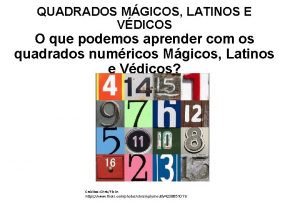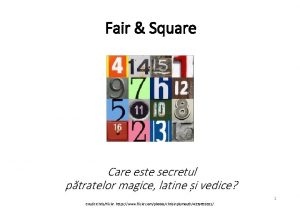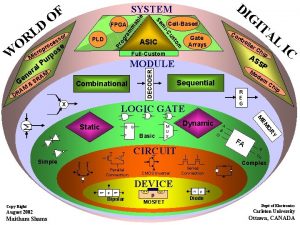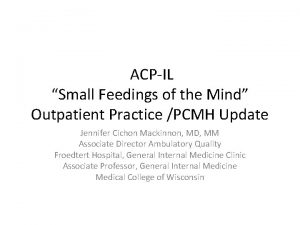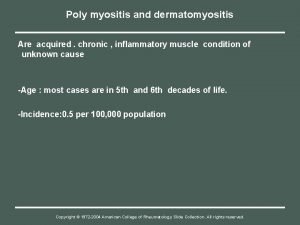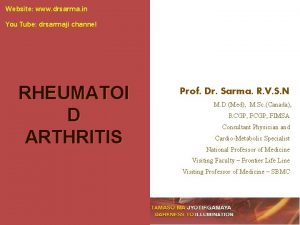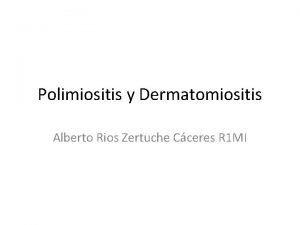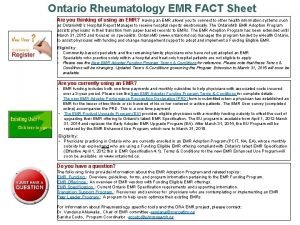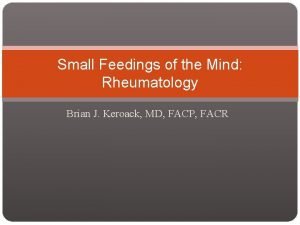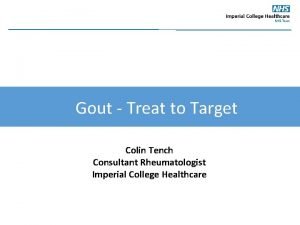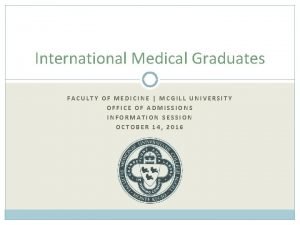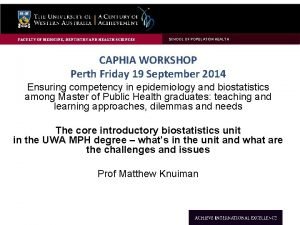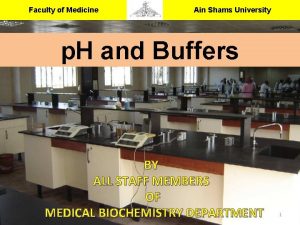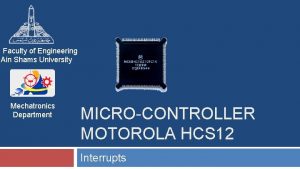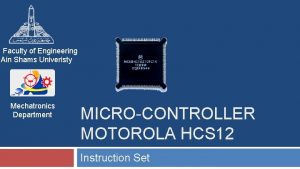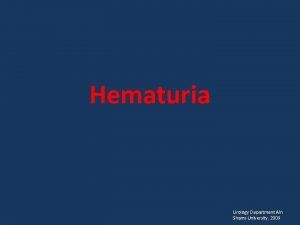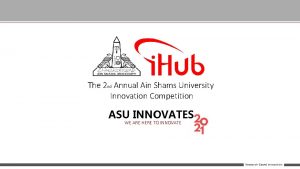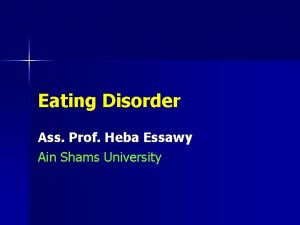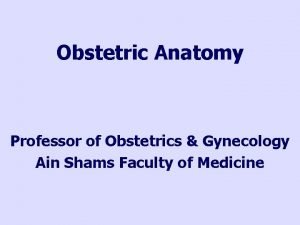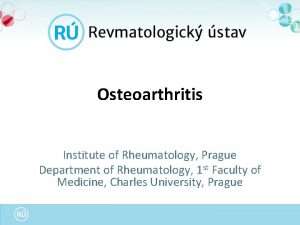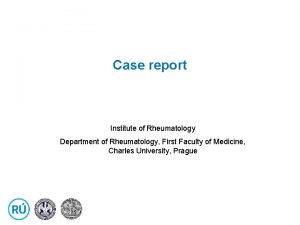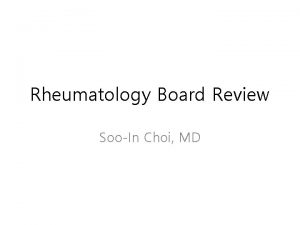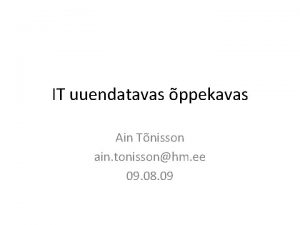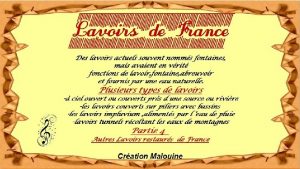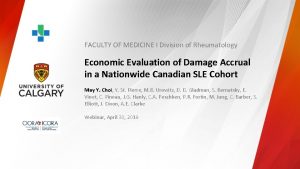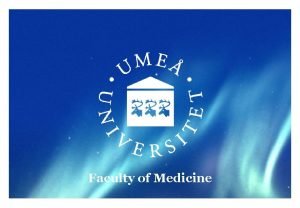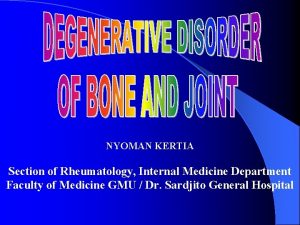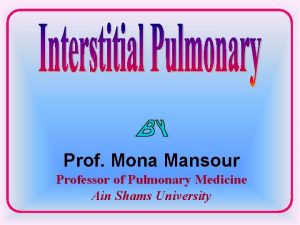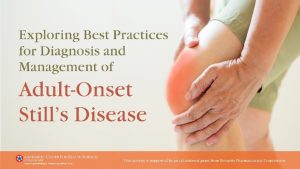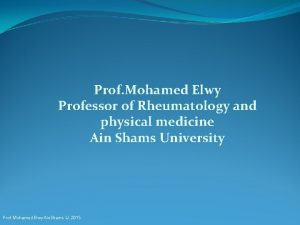Ain Shams University Faculty of Medicine Rheumatology Physical


























- Slides: 26

Ain Shams University – Faculty of Medicine (Rheumatology & Physical Medicine Department)

Ain Shams University – Faculty of Medicine (Rheumatology & Physical Medicine Department) COLD THERAPY By: Prof. Dr. Mohamed Faramawy Professor of Physical Medicine, Rheumatology & Rehabilitation

Ain Shams University – Faculty of Medicine (Rheumatology & Physical Medicine Department) COOLING OF THE TISSUES (ICE THERAPY) § Ice therapy is the local or general application of cold for therapeutic uses. § It can be applied in the form of: * Ice packs. * Ice massage. * Cooled air jets. § When ice is applied to the skin it melts and removes heat from the tissues.

Ain Shams University – Faculty of Medicine (Rheumatology & Physical Medicine Department) The application of cold results in: * Alternate periods of vasoconstriction and vasodilatation. * Reduction of nerve conductivity. * Reduction of muscle spasm and spasticity. § Temperature changes in the tissues will depend on the amount of heat energy removed from the tissues and the rate of removal. § While the skin temperature can be changed abruptly and markedly with the application of cold the deeper tissues are cooled much less and much more slowly.

Ain Shams University – Faculty of Medicine (Rheumatology & Physical Medicine Department) The temperature drop in the tissues will depend on: 1 The temperature difference between the coolant and the tissues. 2 The thermal conductivity of the tissues: Water filled tissues, such as muscle, have a high thermal conductivity compared to fat or skin. 3 The length of time for which the cold is applied. 4 The size of the area that is being cooled: The larger the area, the more heat energy is lost.

Ain Shams University – Faculty of Medicine (Rheumatology & Physical Medicine Department) PHYSIOLOGICAL CHANGES DUE TO COOLING THE SKIN The local effects: § There is immediate vasoconstruction of cutaneous blood vessels, shown by the blanching that occurs. § The vasoconstriction occurs due to a reflex in the autonomic nervous system, which is triggered by stimulation of thermal receptors in the skin. § It is also due to the direct effect of cold on the smooth muscle of the arterioles. § In addition the precapillary sphincters, which are influenced by local hormones (e. g. serotonin and bradykinin), may be involved in local thermoregulation.

Ain Shams University – Faculty of Medicine (Rheumatology & Physical Medicine Department) § This vasoconstriction leads to a dramatic decrease in blood flow through the skin, and hence limits the conduction of heat to the body surface. § The increased blood viscosity, due to cooling, will also contribute to the slowed blood flow. § After some minutes the vasoconstriction may give way to a marked vasodilation which itself may last for 15 min before being replaced by another episode of vasoconstriction.

Ain Shams University – Faculty of Medicine (Rheumatology & Physical Medicine Department) § The cause of this vasodilation is not yet completely elucidated. § Originally an axon reflex mechanism involving a histamine like substance (substance H) to cause local vasodilation was suggested. § As the increased blood flow washes out this substance the vessels constrict again thus continuing the cycle. § Later suggestions include the possibility that as the temperature falls so smooth muscle activity is diminished and constriction is no longer possible. § The consequent vasodilation rewarms the part, the smooth muscle recovers and it constricts again.

Ain Shams University – Faculty of Medicine (Rheumatology & Physical Medicine Department) SUMMARY OF LOCAL EFFECTS OF COOLING 1 Immediate perception of cold → cold receptors are stimulated. 2 Immediate vasoconstriction of cutaneous vessels followed by cold induced vasodilation in some areas, which may continue in a cyclical manner. 3 Reduced muscle blood flow. 4 Lowered metabolic rate, therefore less oxygen uptake. 5 Effects on peripheral nervous system with consequent reduction in pain and hypertonicity. 6 Slowed healing.

Ain Shams University – Faculty of Medicine (Rheumatology & Physical Medicine Department) GENERAL EFFECTS OF LOCAL COOLING § Cooling applied to the skin immediately stimulates cold receptors which are more numerous than heat receptors in any given area of skin. § Although some of these cold receptors will be firing at normal skin temperatures their activity increases greatly as cooling occurs → then diminishing somewhat when cooling becomes steady, i. e. they show adaptation. § Extreme cold is experienced as pain, involving pain receptors. § Both pain and temperature neurons synapse in the posterior horn of the spinal cord; the subsequent neuron ascends in the spinothalamic tract of the opposite side. § Apart from a synapse in the thalamus with a neuron to the sensory cortex, giving awareness of cold, there are many collateral paths, particularly to the hypothalamus. § The hypothalamus acts as a thermostat to maintain core temperature.

Ain Shams University – Faculty of Medicine (Rheumatology & Physical Medicine Department) § The degree of general vasoconstriction that occurs is dependent on the extent of the cooling. § Further, if the temperature drop is great enough shivering will occur. § This increases metabolism, and hence heat production, by irregular muscle contractions. § Awareness of cold leads to behavioural responses to maintain body temperature such as increased activity or putting on more clothes.

Ain Shams University – Faculty of Medicine (Rheumatology & Physical Medicine Department) THERAPEUTIC USES OF COLD 1 Recent injuries: A limits bleeding by vasoconstriction and increased blood viscosity; B limits pain by reducing * The rate of oedema formation. * The production of pain nerve irritants. C reduces the metabolic rate and hence secondary cell necrosis. 2 Alleviation of pain: A acts as above. B reduces the conduction of some pain nerves in skin. C provides sensory stimulation, acting on the pain gate. D gives a strong cold sensation leading to endorphin release.

Ain Shams University – Faculty of Medicine (Rheumatology & Physical Medicine Department) 3 Reduce muscle spasm Is linked to the effect on pain. 4 Reduce muscle spasticity A provides stimulation of cutaneous receptors and reflex inhibition of muscle activity. B affects the muscle spindle directly by more prolonged cooling. C increases viscosity which may diminish rapid stretch reflexes. 5 Cold is also used in chronic inflammation, effusion and facilitation of muscle contraction, strengthening and stretching.

Ain Shams University – Faculty of Medicine (Rheumatology & Physical Medicine Department) METHODS OF APPLYING COLD THERAPY 1 Conduction cooling: A Immersion (i) Local (ii) General B Cold packs (i) Ice packs (ii) Commercially made cold packs, either re usable or disposable C Ice towels D Ice massage (i) Slow for pain relief (ii) Brief for muscle facilitation E Cold compression and cold fluid units 2 Evaporative cooling: Evaporating spray

Ain Shams University – Faculty of Medicine (Rheumatology & Physical Medicine Department) CONTRASTING HEAT AND COLD TREATMENTS 1 Both heat and cold appear to be useful in relieving pain and muscle spasm. 2 Spasticity is reduced by cooling. 3 Recent trauma benefits from immediate cooling, reducing bleeding, rate of oedema formation and pain. 4 Later, the same injury will benefit from mild heating to increase metabolism and gently increase the healing processes. Cold has been shown to diminish healing. 5 The tendency to oedema is encouraged by heating but decreased by cooling. 6 Skilled movements are impaired by cooling. 7 Muscle activity can be facilitated by brief local cooling. 8 Joint stiffness is decreased by heating and increased by cooling.

Ain Shams University – Faculty of Medicine (Rheumatology & Physical Medicine Department) DANGERS AND CONTRAINDICATIONS § There are two ways in which tissue injury might occur. 1 excessive local cold can lead to damage in normal tissues. 2 some pathological conditions may predispose the patient to cold injury due to temperature falls that would otherwise be harmless. § It must be said that in either circumstance damage is rare.

Ain Shams University – Faculty of Medicine (Rheumatology & Physical Medicine Department) Excessive local cold on normal tissue § The mildest form consists of the appearance of erythema and tenderness of the skin a few hours after the application of ice, subsiding in a day or two; this is called an ice burn. § A more severe form, an ice burn with fatty necrosis, shows bruising as well as more tenderness and can last up to 3 weeks. § Such injuries are rare and are said to occur in areas which are underlain by thick subcutaneous fat and which have been cooled rapidly. § With extreme cold, freezing of the tissues can occur and this is referred to as 'frostbite' and only occurs if the body suffers extreme exposure.

Ain Shams University – Faculty of Medicine (Rheumatology & Physical Medicine Department) Certain pathological conditions 1) Cold sensitivity: 1 Vasospasm: § Raynaud's phenomenon is a condition often associated with connective tissue disorders in which excessive vasoconstricton, triggered by cold, occurs in the digital arteries. § Obviously cold treatment should not be used to provoke vascular spasm. § With vascular disorders which are primarily obstructive, such as arteriosclerosis, cold treatments are considered unsuitable by many but the reasons are unclear.

Ain Shams University – Faculty of Medicine (Rheumatology & Physical Medicine Department) 2 Cryoglobinaemia. § An abnormal protein is present in the blood; it can form a precipitate at low temperatures blocking blood vessels and thus causing local ischaemia. § Although not common, this condition can also be found in association with some of the connective tissue disorders such as systemic lupus erythematosus and rheumatoid arthritis. 3 Cold urticaria. § Cold causes the release of histamine from mast cells leading to a local weal and erythema and sometimes general (systemic) symptoms such as lowered blood pressure and raised pulse rate.

Ain Shams University – Faculty of Medicine (Rheumatology & Physical Medicine Department) 2) Cardiac disease § Coronary thrombosis and anginal pain have sometimes been provoked by cold leading to the suggestion that locally applied ice may cause reflex vasoconstriction of the coronary arteries and should therefore not be given to patients who have coronary artery disease.

Ain Shams University – Faculty of Medicine (Rheumatology & Physical Medicine Department) 3) Arterial blood pressure § Cooling larger areas, such as a limb segment, can lead to a transient rise in arterial blood pressure. § This could be dangerous for hypertensive patients or those with especially labile blood pressure. § Monitoring the blood pressure during and for a short time after treatment would be advisable if large areas are to be cooled.

Ain Shams University – Faculty of Medicine (Rheumatology & Physical Medicine Department) 4) Sensory deficiency § The neurological effects of cooling, such as facilitation of muscle contraction, require intact sensory nerves. § Therefore caution is required if skin with defective innervation is to be treated.

Ain Shams University – Faculty of Medicine (Rheumatology & Physical Medicine Department) 5) Hypersensitive areas § The region of the ear because there may be some effect on the vagus nerve. § Similarly the medial aspect of the knee or the axilla in obese patients is said, to be more susceptible to ice burns.

Ain Shams University – Faculty of Medicine (Rheumatology & Physical Medicine Department) 6) Emotional and psychological features § Some patients may have a strong aversion to cold in any form or to local cold applications in particular.

Ain Shams University – Faculty of Medicine (Rheumatology & Physical Medicine Department) Precautions with particular cooling methods § It has already been noted that evaporating sprays can lead to rapid local cooling so that prolonged application cause skin damage. § Applications should therefore be restricted to sprays of about 5 s separated by 10 or 20 s intervals and the skin should be constantly inspected. § Ethyl chloride is inflammable, so naked flames and heaters should be avoided; also the vapour should be kept clear of the eyes and not inhaled. § It is important to understand that ice packs with temperature below (0 °C) should be separated from the skin by a wet towel.

Ain Shams University – Faculty of Medicine (Rheumatology & Physical Medicine Department) Thank you ……
 Hubert kairuki memorial university faculty of medicine
Hubert kairuki memorial university faculty of medicine Semmelweis university faculty of medicine
Semmelweis university faculty of medicine King abdulaziz university faculty of medicine
King abdulaziz university faculty of medicine Territorial matrix vs interterritorial matrix
Territorial matrix vs interterritorial matrix Faculty of veterinary medicine cairo university logo
Faculty of veterinary medicine cairo university logo Hacettepe university faculty of medicine
Hacettepe university faculty of medicine Dosrsal
Dosrsal Semmelweis university faculty of medicine
Semmelweis university faculty of medicine Faculty of veterinary medicine cairo university
Faculty of veterinary medicine cairo university Cairo university faculty of veterinary medicine
Cairo university faculty of veterinary medicine Shams al ma'arif
Shams al ma'arif Patrat magic 3x3
Patrat magic 3x3 Saeed sharifi
Saeed sharifi Sana shams
Sana shams Maitham shams
Maitham shams Vbpm rheumatologists
Vbpm rheumatologists Andres quiceno
Andres quiceno Symmetryical
Symmetryical Rheumatology org
Rheumatology org Rothschild
Rothschild Manos de mecanico dermatomiositis
Manos de mecanico dermatomiositis Ps suite emr cost
Ps suite emr cost Enthesitis
Enthesitis Dr. colin tench
Dr. colin tench Mrbs scholarship
Mrbs scholarship Mcgill medicine supporting documents
Mcgill medicine supporting documents Faculty of medicine dentistry and health sciences
Faculty of medicine dentistry and health sciences










